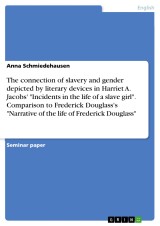Details

The connection of slavery and gender depicted by literary devices in Harriet A. Jacobs' "Incidents in the life of a slave girl". Comparison to Frederick Douglass's "Narrative of the life of Frederick Douglass"
1. Auflage
|
CHF 7.00 |
|
| Verlag: | Grin Verlag |
| Format: | |
| Veröffentl.: | 18.06.2024 |
| ISBN/EAN: | 9783389036891 |
| Sprache: | englisch |
| Anzahl Seiten: | 13 |
Dieses eBook erhalten Sie ohne Kopierschutz.
Beschreibungen
Seminar paper from the year 2023 in the subject American Studies - Literature, grade: 2,7, Friedrich-Alexander University Erlangen-Nuremberg, language: English, abstract: The paper analyzes the connection of slavery and gender depicted by literary devices in Harriet A. Jacobs’ "Incidents in the life of a slave girl" compared to Frederick Douglass’s "Narrative of the life of Frederick Douglass". This paper is going to examine a few examples of the language and literary devices in these narratives and how they function.
In the first section of the paper the focus is on the literary depiction of slavery and gender in "Incidents in the life of a slave girl". In the second part the portrayal of these two characteristics is examined in "Narrative in the life of Frederick Douglass". In the third chapter, the attributes already mentioned are compared to each other. Finally, a conclusion follows. The literature used contains these two slave narratives by Jacobs and Douglass, as well as other writings about these narratives, literary stylistic devices, and the slave topic in general.
The year 1773 was essential to the beginning of African American literature in general and also for the genre of slave narratives. By publishing her first book of poetry and being the first female black writer, Phillis Wheatley paved the way for the development of black literature. As part of this development, the genre of slave narratives emerged as well. Slave narratives are written stories of African American slaves and their personal experiences and sufferings during their time of enslavement.
Their escape into freedom was often a turning point in the story. The author of these stories wrote them to depict the dehumanising and degrading effects of slavery. Furthermore, slave narratives were written especially for a white audience, since the narrators wanted to obtain that readers believed in the horrors they had to endure and to show the importance of abolishing the institution of slavery. To achieve that the narrators often used a very distinctive and vivid language in their narratives to support the imagination of their readers.
In the first section of the paper the focus is on the literary depiction of slavery and gender in "Incidents in the life of a slave girl". In the second part the portrayal of these two characteristics is examined in "Narrative in the life of Frederick Douglass". In the third chapter, the attributes already mentioned are compared to each other. Finally, a conclusion follows. The literature used contains these two slave narratives by Jacobs and Douglass, as well as other writings about these narratives, literary stylistic devices, and the slave topic in general.
The year 1773 was essential to the beginning of African American literature in general and also for the genre of slave narratives. By publishing her first book of poetry and being the first female black writer, Phillis Wheatley paved the way for the development of black literature. As part of this development, the genre of slave narratives emerged as well. Slave narratives are written stories of African American slaves and their personal experiences and sufferings during their time of enslavement.
Their escape into freedom was often a turning point in the story. The author of these stories wrote them to depict the dehumanising and degrading effects of slavery. Furthermore, slave narratives were written especially for a white audience, since the narrators wanted to obtain that readers believed in the horrors they had to endure and to show the importance of abolishing the institution of slavery. To achieve that the narrators often used a very distinctive and vivid language in their narratives to support the imagination of their readers.
Diese Produkte könnten Sie auch interessieren:

American Consumer Culture and its Society: From F. Scott Fitzgerald`s 1920s Modernism to Bret Easton Ellis`1980s Blank Fiction

von: Johannes Malkmes

CHF 64.99
















